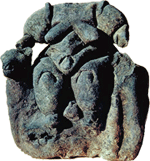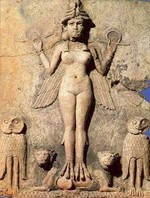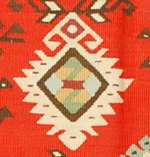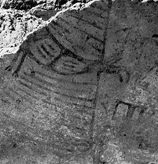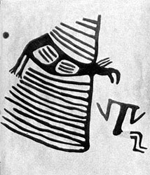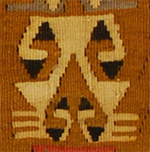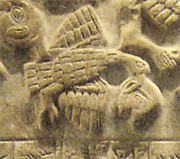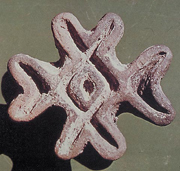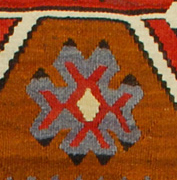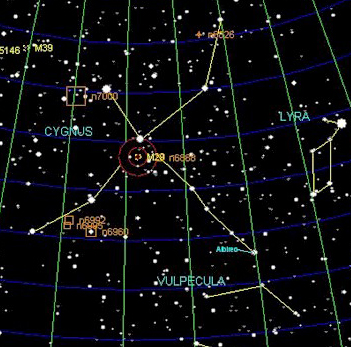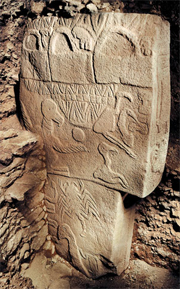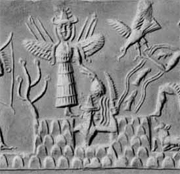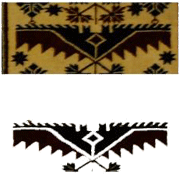VULTURES OVER THE MOTHER GODDESSOne of the most common symbols we encounter on kilims is the so called "elibelinde" (hands on hips). The symbolic meaning of patterns can be explained in reverse chronology like this:
Although they all produce some kind of culture, it will be the last one what this article will try to trace. Rather than an academic study, we aim to provide some objective data and give a framework what the reader can speculate on, after scanning a numerous amount of resources. Besides the widely sympathized "Mother Goddess Theory", we will introduce two alternative arguments.
|
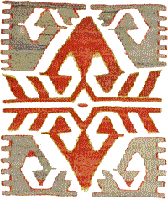
|
|
1- THE MOTHER GODDESS THEORYThe most believed interpretation about the origin of the "elibelinde" is that it traces back to the "Mother Goddess", named Kybele, Kubaba, Artemis or Ishtar by different cultures in the history. Since we don't have any kilim like weaving left from the ancient times, we will compare it with other objects like statues, stone carvings or murals. Not oldest but the most popular among those is the mother goddess figurine dating to the 7th millennium, found during Çatalhöyük (Central Turkey) excavations during 1960's. Like the later Phrygian and Byzantine versions, this sample dominates the two lions on her both sides. To deny that these lions evolved into the zig-zags of the elibelinde pattern is as hard as accepting the absolute accuracy of it. But it is also that much accurate that both the statue and the elibelinde pattern have a "dominant" expression. Since the mother goddess is a symbol of fertility, the argument is consolidated with another little elibelinde or at least another symbol in the middle or "between the legs". Ishtar, the sumerian mother goddess completes the puzzle giving the zig-zags to the elibelinde with her wings and feathers. |
1- Mother Goddess, Çatalhöyük, 6500 BC
2- Ishtar or Inannaomega, Sumer, 2500 BC
20th Balkan Kilim |
2- THE VULTURE AND REINCARNATIONBased on the findings in Çatalhöyük we assume people to serve corps to vultures and bury their bones under their houses after the flesh (and the spirit) is taken to the sky by the vultures. The vulture seems to have an important meaning after death as much as the mother goddess has during life. When James Melaart, chief of Çatalhöyük excavations during 1960's published his book late 80's, me and my friends were very excited by the transcripts displaying murals of Çatalhöyük where nearly the same patterns of contemporary kilims were drawn. So much was I also disappointed when I searched for those murals and found out that they didn't exist. So I will be much more careful this time. The vulture and human body without a head on the right is drawn from the mural below.
Besides this you might find drawings with towers where vultures fly around with kilim patterns on their back or mother goddess figures giving birth but you can't find the archeological objects they are based on. The mission of the vulture as a courier was not seen only in Çatalhöyük but also in a wide territory stretching from Siberia to the west until America, for thousands of years. The vulture or vulture-god-goddess figure can be traced starting at the 10th millennium at the Göbeklitepe Temple (southeast Turkey) until Sumerians, ancient Egypt and Maya's. |
3- Transcript of the Çatalhöyük vulture mural
20th Century Anatolian kilim
6- Seal, Çatalhöyük, early neolithic
|
3- THE VULTURE AND ASTRONOMYIdeas, beliefs, events and concepts are so much subject to distortion, as much as exciting they are. Sometimes we believe so strong that we can not protect our belief against lies supporting it. At the end evidence is obfuscated by rumor. So I will not dive into this subject more than my breath endures. But I have to admit that it deserves a deep research. The excavations held since 1994 in Göbeklitepe revealed a very important milestone of the history of civilization. The first temple of humankind dating to the 10th millennium consists of four similar structures where 20 T-shaped stones form a circle. In contrast to its 7000 thousand years younger version Stonehenge many of the those stones here were decorated with carved animal figures like vulture, scorpion, fox or bear. None of the animal figures depict a hunting scene or another use to those hunter-gatherer people. One feature you can see at the first glance is the un-arrangement of those symbols despite the temples well-arranged form. These are basic facts so far, without any contribution of my or someone else's imagination. Let's try to comment them. Both Göbeklitepe and Stonehenge have a horizon of 360 degrees like an observatory and face to the north. The rotational axis of the earth is accepted to be fixed, pointing to the polar star at the north. In fact it moves in a circle where it takes about 26.000 years to point the polar star again. During the time when the temple of Göbeklitepe was build, people would see the Cygnus at the north, a different constellation than the Little Bear.
10- The Cygnus Constellation In ancient mythology the Cygnus is associated with a swan, vulture, or eagle. Sumerian, ancient Egyptian or Mayas were not only interested in the vulture but also in astronomy. The reason that we encounter the vulture figure only among those civilizations is that others have not left many solid objects like rocks or metal. Asian tribes for instance practiced vulture shamanism until present time. The astronomy theory doesn't seem to conflict with the reincarnation theory. They might even compliment each other against the mother goddess. |
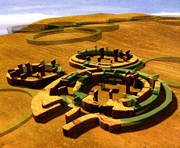 7- Model of Göbekli Tepe Temple
8- Göbekli Tepe Temple, 10th millennium BC
20th century west Anatolian tribal pile rug |
CONCLUSIONUsing the present data, we can trace kilims back until the 14-15th century. Other weavings using kilim patterns date back to the 7-9th century. Thus we have to seek for the origin of patterns in older times. The limitations of the weaving technique to draw patterns as clear as stone carvings or murals brings up much more abstract figures. Except for angels, we didn't encounter any element of the present religions corresponding the "human with wings" appearance of the elibelinde. The three different arguments mentioned above are not proven truth. But the truth obviously resides somewhere hard to reveal.
|
|
RESOURCES1) www.columbia.edu
|

